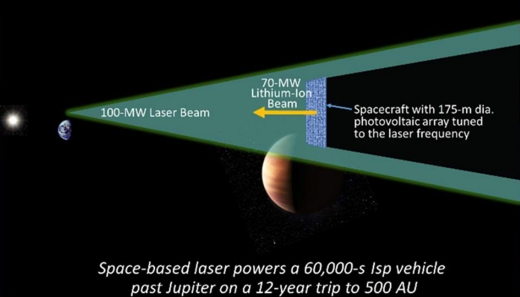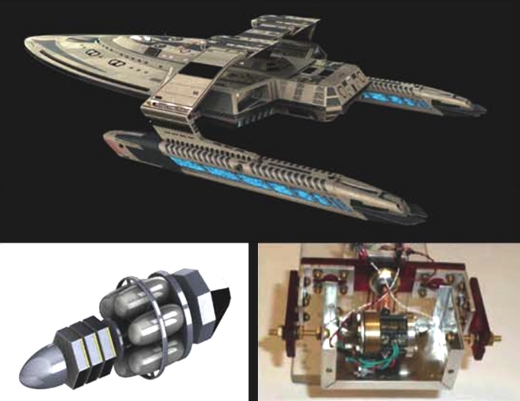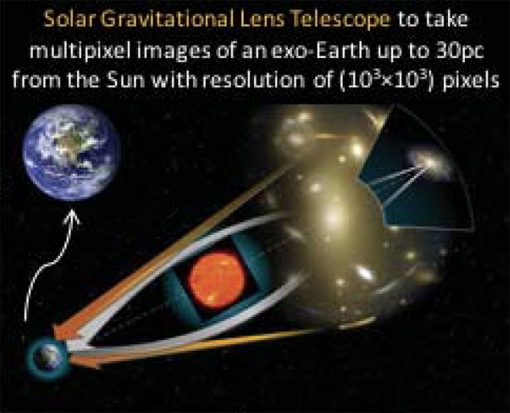I always look at the NASA Innovative Advanced Concepts (NIAC) awards with interest as well as a bit of nostalgia. When I began researching the book that would become Centauri Dreams, NIAC was an early incentive. Then known as the NASA Institute for Advanced Concepts, it was under the direction of Robert Cassanova (this was back around 2002), and its archive of funded studies was a treasure house of deep space ideas, from antimatter extraction in planetary magnetic fields to exoplanet imaging through starshades. I spent days going through any number of reports and interviewed many NIAC study authors.
You can still see the NIAC reports from that era on the older site (go to NIAC Funded Studies). The current NIAC site makes the point that the program looks for “non-traditional sources of innovation that study technically credible, advanced concepts that could one day ‘change the possible’ in aerospace.” And it’s here that we get the 2017 Phase 1 proposals, a $125,000 award for a nine month period that can result in a two-year Phase II follow-up.
Laser-Fed Ion Drive for Interstellar Precursor
2017 proposals with specifically interstellar intent include one from JPL’s John Brophy, who describes what he calls “A Breakthrough Propulsion Architecture for Interstellar Precursor Missions.” Brophy is looking for a way to deliver a high spacecraft velocity change (delta-V) without using much propellant. He envisions a lithium-fueled ion thruster with a specific impulse of 58,000 seconds (compare this with the Dawn spacecraft’s 3,000 seconds).
How to achieve this? By use of a 10-km orbital laser array that allows his craft to operate far beyond the point where sunlight loses its useful effect, the array feeding a lightweight, photovoltaic array aboard the spacecraft that can produce the electric power to drive the thrusters. Brophy believes laser power in this configuration can be converted to electric power at an efficiency of 70 percent, to produce an output voltage of 12 kV. The lithium fueled system would be capable of a 12-year flight-time to 500 AU, close to the point where gravitational lensing begins to get interesting. Time to Pluto: 3.6 years, and Jupiter in a single year.
So much depends upon that laser array, a ground-based version of which is under active study by the Breakthrough Starshot effort. The problems of implementing such an array are daunting, but its uses if ever built are so game-changing that the investigation continues. Breakthrough Starshot itself works with a 30-year horizon, so we are not talking about near-term implementation, but rather sketching out concepts a laser array could make feasible.

Image: Breakthrough Propulsion Architecture for Interstellar Precursor Missions
Credit: John Brophy.
Counting on Ernst Mach
Like Brophy’s proposal, Heidi Fearn’s “Mach Effects for In Space Propulsion: Interstellar Mission” is a Phase 1 initiative, an interesting entry because it shows NIAC beginning to open to the kind of breakthrough propulsion concepts NASA once investigated through its Breakthrough Propulsion Physics project (led by Tau Zero founder Marc Millis). In this case, the work goes toward a so-called Mach Effect Thruster (MET). Mach effects are transient variations in the rest masses of objects as predicted by standard physics where Mach’s principle applies. Proponents believe they offer the possibility of producing thrust without the ejection of propellant, as discussed in James Woodward’s Making Starships and Stargates: The Science of Interstellar Transport and Absurdly Benign Wormholes (Springer-Verlag, 2012).
What Fearn proposes is to investigate such thrusters by continuing the development of laboratory-scale devices while designing and developing power supply and electrical systems that will determine the efficiency of the Mach Effect Thruster. The analytical task is to improve theoretical thrust predictions and build a reliable model of the device. At the theoretical level, this team is definitely talking deep space, with part of the proposal being to:
Predict maximum thrust achievable by one device and how large an array of thrusters would be required to send a probe, of size 1.5m diameter by 3m, of total mass 1245 Kg including a modest 400 Kg of payload, a distance of 8 light years (ly) away.

Image: Mach Effects for In Space Propulsion: Interstellar Mission. Credit: Heidi Fearn.
Can such a device work? Remember, we are in the realm of advanced concepts, where the technology is at the TRL 1 level, but the benefits of working with a thruster that does not expel fuel mass could make high velocities possible, enough of an incentive to pursue these early steps. Mach’s principle relates the motion of the farthest objects in the universe to the local inertial frame or, as Hawking has it, “Local physical laws are determined by the large-scale structure of the universe.” The principle is vague enough that Hermann Bondi and Joseph Samuel have compiled eleven different variations on it, all of which could be called Machian.
Gravitational Lensing and Exoplanet Imaging
JPL’s Slava Turyshev is behind a Phase 1 study called “Direct Multipixel Imaging and Spectroscopy of an exoplanet with a Solar Gravity Lens Mission,” a study focusing on a mission to exploit the Sun’s gravitational lens, where (at 550 AU and beyond) the Sun’s gravity has bent the light of objects directly behind it to allow powerful lensing effects.
Long-time Centauri Dreams readers will know that the Italian physicist Claudio Maccone has championed a gravitational lens mission called FOCAL for many years, proposing it to the European Space Agency and writing numerous papers as well as two books on the topic (there is much available in the archives here about this concept). The definitive book, Deep Space Flight and Communications: Exploiting the Sun as a Gravitational Lens (Springer, 2009) lays out the principles of such lensing, the history of its study, and potential solutions to the many imaging issues raised by a space mission. Maccone has discussed lensing as one solution to the communications challenges of Breakthrough Starshot.
What Turyshev is proposing is to study not the means of getting to 550 AU and beyond, but the question of spacecraft operations at such distances. From the proposal description:
Specifically, we propose to study I) how a space mission to the focal region of the SGL (Solar Gravitational Lens) may be used to obtain high-resolution direct imaging and spectroscopy of an exoplanet by detecting, tracking, and studying the Einstein’s ring around the Sun, and II) how such information could be used to unambiguously detect and study life on another planet.

Image: Direct Multipixel Imaging and Spectroscopy of an exoplanet with a Solar Gravity Lens Mission. Credit: Slava Turyshev.
Other proposals of interest are “Pluto Hop, Skip and Jump Global,” from Benjamin Goldman (Global Aerospace Corporation), an innovative study of a Pluto lander with a novel approach to landing and in situ science; “Gradient Field Imploding Liner Fusion Propulsion System” from Michael LaPointe (NASA MSFC), exploring magneto-inertial fusion in a new configuration that could lend itself to in-space propulsion; and “Fusion-Enabled Pluto Orbiter and Lander,” from Stephanie Thomas (Princeton Satellite Systems, Inc.), a Direct Fusion Drive concept based on work under development at the Princeton Plasma Physics Laboratory, and its application in a Pluto orbiter with lander (this one is a Phase II study).
The full list of 2017 Phase I and Phase II selections is here, including Nan Yu’s interesting take at JPL on possible dark energy interactions with a ‘Solar System laboratory.’ Have a look at these and ask yourself which we may still be talking about a decade hence. When I look back to the NIAC studies I examined in 2002 and later, I find many ideas that we wound up discussing at length here on the site, and I wouldn’t be surprised if several of the new selections move on to Phase II status and a great deal of future scrutiny. Which ones will they be?



ANOTHER “heads up”. ALL READERS should log on to the most recent blog on the Astro Wright website, dealing with “outre ideas”, and read my response ASAP! THEN: RSVP on the most recent SETI post on this website(I think it is the one about FRB’s as propulsion for lightsails)!!!
Re: Heidi Fern Mach Effect Thruster.
These devices Seems to be the most likely to yield undisputable results.
and seem grounded in a theory (Mach inertia derived from W-F absorber theory) that negates the Perpetual motion machine argument.
Unfortunately, the effect is much smaller in magnitude than Sonny White’s
laboratory results. And the great caveat, that is a lot charge being placed on
those Piezo Electric devices. Are there good papers on how they behave at high voltages and currents, individual as well as stacked PZ configurations?
Rob, I don’t have the answer on papers on this effect, but I’m looking into a Tau Zero review of the concept that would appear here and contain that information. I hope I can get this together some time soon, though much depends on the schedule of possible contributors.
W-F Absorber theory seems rather speculative itself and makes assumptions about how the universe works. And how would it negate the perpetual motion machine argument? Where would the energy come from because it’s going to gain more kinetic energy than is directly put into it in some frame. Even Woodward states this yet he doesn’t see it as a problem anymore than Shawyer does. They both see it as a phony problem based on flawed assumptions.
The work of Woodward/Fearn leads to the same exact issue as the EmDrive yet physicists somehow see it as more palatable because they claim the theory is more comprehensible. It’s also more palatable because the effect is a lot smaller which makes it less of a threat in the near term.
” And how would it negate the perpetual motion machine argument? ”
The argument against perpetual motion machines is that they have no input to explain their output. Input to a MET would be momentum from the rest of the universe.
It’s not free energy if you know where it’s coming from.
I agree with you that the momentum and energy has an apparent source so it’s not a PPM. The EmDrive would also do that but the theory is less clear. Still, if it worked, it’s mind boggling to think the stars would be in (I won’t say easy) reach with such technology as Fearn says a 5-9 Ly journey would be accomplished in some twenty years.
“A future goal would be interstellar travel to the nearest exoplanet, within 5-9 ly distance. A mission of this type might take 20 or more years using the MET thruster. ”
And also the goal of the work is to “Predict maximum thrust achievable by one device and how large an array of thrusters would be required to send a probe, of size 1.5m diameter by 3m, of total mass 1245 Kg including a modest 400 Kg of payload, a distance of 8 light years (ly) away.”
I almost can’t believe I’m even reading these statements being put forward as serious possibilities! I hope it proves out.
We are indeed living in interesting times.
Not long ago there wasn’t even a hint how these things may come to happen in practice.
Now there are experiments trying to prove the concepts.
Of course, it may turn out to be nothing. But if it is something… interesting times!
Some of these concepts could make plausible a probe to Planet Nine, if we find it.
Paul,
You’ve featured countless papers by many illustrious writers exploring, in the most general sense, the use of ‘beamed’ energy that would provide thrust for some sort of vehicle.
These vehicles all require gargantuan energy sources, energy that is quickly subsumed by the infernal Inverse Square Law.
But what if the power sources were more manageable? Instead of being gargantuan and few, imagine a series of ‘beamers’ along the spacecraft trajectory, each nudging the fleeing spacecraft along. Indeed, like a marathon runner grateful for water passed by the faceless crowd, our stalwart spacecraft would be incrementally accelerated.
Perhaps these beam stations could be placed far in advance, storing energy from the sun that is then discharged at the appropriate time (capacitive storage?). Such a system would be less vulnerable to charges of weaponizing as well.
This notion isn’t new to me – I saw it in print and not long ago, but simply cannot recall. It’s in an SF story; someone will recall I am sure. And as it isn’t a new idea, perhaps there’s a fatal flaw that is not clear to this non-scientist.
Ther was the suggestion of using beams in a relay for interstellar travel.
In the solar system, this is not so easy. The beamers would be traveling in different orbits and you would need a lot of them to provide an approximately shortest path for the vehicle to maximize beam intensity. The cost of this might not make this approach worthwhile until there was substantial traffic to use all the beamers efficiently.
Beaming energy is clearly a very useful approach for delivering power to spacecraft and facilities, especially where solar energy is weak. At this early stage, we should be testing different technologies rather than prematurely trying to optimize for some system.
Ah. The issue of different orbits is one I realized is far from trivial.
But: over the years reading here and elsewhere, the energy requirements for fixed beam sources described by Dr. Benford and others is so huge that I supposed I thought it to be the primary show-stopper. Indeed the energy requirements have been compared to the energy consumed by the denizens of the entire planet- not today but in some forward time. And that being the case, relays start to make sense, orbits not withstanding.
I take your point though that perhaps this issue is in the future.
The four I like that are not to far off in the future;
Mach Effects for In Space Propulsion: Interstellar Mission, Heidi Fearn.
Phobos L1 Operational Tether Experiment, Kevin Kempton.
Sutter: Breakthrough Telescope Innovation for Asteroid Survey Missions to Start a Gold Rush in Space, Joel Sercel.
Stellar Echo Imaging of Exoplanets, Chris Mann.
Have been trying to find more info on Stellar Echo Imaging of Exoplanets without much luck. It has reach the Phase II studies so it might be feasible soon! If anyone has found a more in depth report on this project please advise.
I can remember in the Apollo heydays all these crazy ideas for getting around on the moon. They always sound great but funding and a good reason to use them makes or breaks it. A lot of these types of projects could be merged and improved over time, and NIAC is doing a much better and a more in depth studies then the lunar hoppers of the Apollo era.
If Mach effect thrusters are real, all the others become obsolete.
Because they are by their very nature compact and low energy devices, with efficiency well above any conventional thruster, because they would actually violate CoM and CoE from our local perspective, even if they are supposedly taking their excess kinetic energy from the far reaches of the cosmos.
This, of course, is the main point of criticism of this kind of devices, but we aren’t going to the stars by being timid in our assumptions.
Glad to see NASA willing to go a little bit off the beaten path, though.
NASA’s Newest Interstellar Concepts Rely on Huge Laser Arrays and Gravity Surfing.
“Yet the MEGA drive has taken a while to find mainstream traction, partly because it doesn’t fit into the wild and speculative mould that people normally associate with revolutionary technology.
“It’s conventional and breakthrough,” Woodward, who is a consultant on the NIAC proposal, told me in a joint phone call with Fearn. “This case is an oddball because there’s a new calculation using standard old physics that says if you do stuff in just the right way, you can produce this interesting effect.”
“Where we are in this case is not the same place as where some people are with these sorts of [NIAC] studies,” he continued. “We already have experimental evidence that shows that these effects can indeed be generated in the laboratory. As soon as people with resources figure out that this is actually real physics, that the gizmos really are feasible and it can be done, we will see a resource investment of significant proportions and it will get done a lot faster.””
https://motherboard.vice.com/en_us/article/nasa-interstellar-space-missions-concepts-niac
Agree. Mach effect thrusters (MET), if real, are a curiosity apparently born from theories compatible with GR to the letter, with a little bit of extrapolation resulting in testable predictions.
This makes them a rara avis among ‘fringe’ theories, because they are very falsifiable, requiring only their actual implementation and validation in a relatively cheap and simple tabletop experiment.
Let’s remember that String theory(es) have a lot of time extending known theories, and yet they still haven’t produced a single prediction that is falsifiable with existing technology and means.
The fact that someone can actually test METs in a regular lab setting is refreshing to say the least.
Trump’s Transition Team Asked NASA About Surveying the Moon for Valuable Resources.
“Specifically, Trump’s team—which is made up of several space entrepreneurs, including Charles Miller of NextGen Space—has inquired about NASA’s ability to develop technology for commercial use, as well as the agency’s plan to survey the Moon for useful raw materials and evaluate the potential of their extractability (a.k.a. mining). ‘
https://motherboard.vice.com/en_us/article/trump-transition-nasa-foia-moon
NASA responses to Trump Transition ART.
Very good 92 page Pdf file!
https://www.documentcloud.org/documents/3553590-NASA-responses-to-Trump-Transition-ART.html
That is how and why humanity will establish a permanent foothold in space: Not for science but money and resources. Same reason Europe went to the New World. Just the way humans work. Some day we may evolve.
Here is Woodward’s comment on the supposed CoE issue.
http://ssi.org/epi/Over-Unity_Argument_&_Mach_Effect_Thrusters.pdf
May sustained fusion power finally happen?
https://www.energyvoice.com/otherenergy/137847/uk-reactor-takes-first-steps-towards-fusion/
“But harnessing and raining in the mighty forces involved is a daunting challenge.”
LOL
When it rains, it fusions.